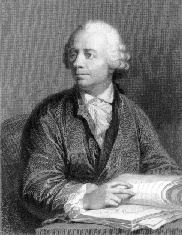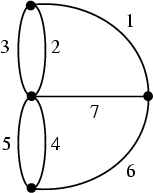The Mathematics of Leonhard Euler (1707 - 1783) (Swiss)
 |
|
Leonhard Euler (pronounced 'oiler') of Basel, Switzerland, is an extraordinary
mathematician. He alone has produced more works than any other
mathematicians. All of these works are of extremely high quality, and he
produced the most ingenious and beautiful proofs ever. Even until now, his
works are still under compilation and revision. He is truly a mathematical
genius. He lost the sight in the right eye at about 30 and then both in
his early 60s. Even when he has gone totally blind, he was still constantly
producing great works. He would work through highly complicated
calculations and derivations in his mind, and recite the statements
one-by-one to his daughter, who does the writing for him. His memory has
to be extraordinary to do this. He was productive till the end. He has contributed to almost all fields of
Mathematics and he is also the founder of other fields, e.g. Topology. He
introduced the world to many of the mathematical symbols used by us today.
Among these are e, the base of natural logarithm, and i, the
square root of -1. He published the first great textbook on analysis in
1748 Introductio in analysin infinitorum (Introduction to the
Analysis of the Infinites). |
Euler was a friend of Daniel Bernoulli. When
Daniel's brother, Nicholas Bernoulli, died in 1726, Daniel recommended Euler for
the post at the St Peterburg Academy (founded 1725) in Russia. Euler took it up
in 1727. When Daniel left for Basel in 1733, Euler assume the chair of
Mathematics. He worked there for 13 years. Then in 1741, he was invited to be
the director of Mathematics at the Academy of Science in Berlin and he stayed
there for 25 years. After that, he returned to Russia to resume his position,
which was still open for him! He stayed there for the rest of his life.
Here's a sample of his great many works.
1. Pentagonal Number Theorem
Pentagonal numbers are numbers of the form
n(3n-1)/2, where n is a natural number. The generalized pentagonal
numbers are of the same form, but with n as integers. It is easy to show
that the generalized pentagonal number is of form n(3n-1)/2 or
n(3n+1)/2. Euler proved that,
2. Euler Identity
The interesting identity,
was proved by Euler, while trying to solve
Bachet's Conjecture, which states that every positive integer can be written as
the sum of at most four squares. Bachet's Conjecture is a special case of Fermat's Polygonal
Number Theorem.
3. Euler Polyhedral Formula
Consider a simply-connected polyhedron of V
number of vertices, F number of faces and E number of edges. Euler proved that,
V + F - E = 2
This is later generalized by Poincare to
V + F - E = 2-2g,
for a surface of genus g. The genus of a surface is the number of
holes in the surface.
4. Euler Formula
Euler proved the following formula,
cosx + isinx =
eix
and deduced the beautiful and extraordinary formula that links the 5
fundamental constants in Mathematics, namely, e, i,
π, 1 and 0, together.
eiπ + 1 = 0
5. Graph Theory
Euler's solution to the K�nigsberg Bridge problem (a
Graph Theory problem) marks him as the founder of Topology. The graph is shown
below. The aim is to traverse the graph with a pencil without lifting the pencil
or retracing the lines. You'll find that this can't be done.

Euler noted that all the nodes have an odd number of edges joined to them. He
showed that this is sufficient to prove the impossibility of traversing the
graph. The word 'topology' was coined by Johann Listing in 1836. Listing
wrote a book Preliminary Sketch of Topology in 1847.
Other accomplishments
i. Every prime of the form
6n+1 can be written in the form
x2+3y2.
ii. Euler modified formula
iii. Euler-Mascheroni constant

iv. Basel Problem
v. Euler Product Formula
vi. Euler-Maclaurin series
Short notes on some of the mathematicians mentioned in this page.
1) Bachet () ()
2) Johann Listing () () was a
professor of mathematical physics at G�ttingen
University. He independently discovered the M�bius strip in 1858 (same
year as M�bius).
3) Mascheroni () ()
4) Colin Maclaurin () (Scottish) worked independently of Euler in 1740.
Return to Maths
Homepage





